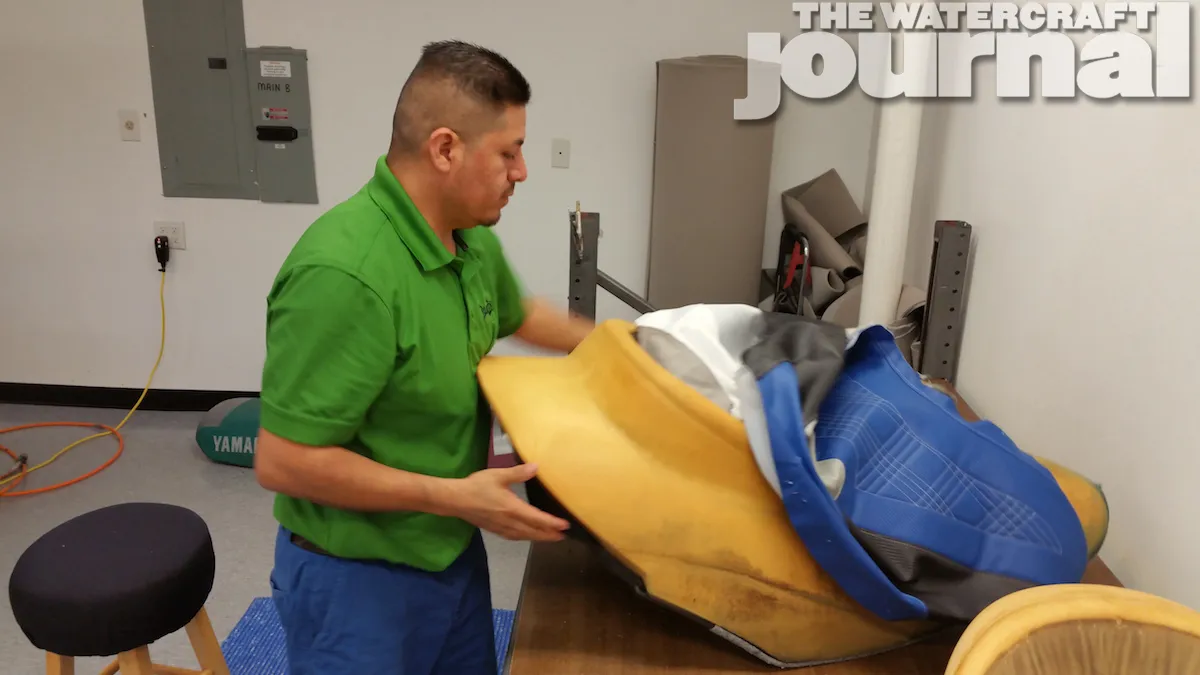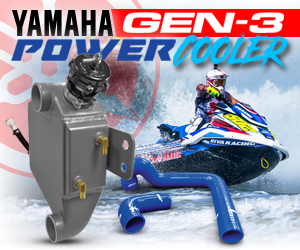Like other enthusiasts, we love our personal watercraft and would do about anything for them! Well, maybe that’s a little much for some of you, but keeping your ski in good condition with a bit of personalization is imperative.
That’s where Watercraft Superstore’s line of Blacktip Jetsports replacement seat covers come in. There is no better way to make your baby look new again, or add that customized look, than with a new seat cover to cover where you sit.
Yes we know… the elephant in the room; “How do I put the new seat cover on” you ask? We at The Watercraft Journal are here to help! We recently made a trip to Watercraft Superstore headquarters to shadowed Blacktip’s expert installer who walked us through a few tricks to use during this process. These details will help make you look like a pro when finished!
Above: A few basic tools of the trade will make your life easier while recover that old seat: a long straight blade screwdriver, a pair of needle nose pliers and/or a staple puller, a staple gun, staples (preferably stainless steel), a razor blade, scissors and to make things really easy on yourself, a heat gun.
Above left: First you need to remove that old, faded, worn out seat cover by flipping the seat upside down, wedging the screwdriver between your old seat cover and the seat base and rip up and away! Above center: Continue around the entire edge of the seat base until the cover is completely torn free. Flip the seat back over and remove the old cover.
Above left: Your new Blacktip cover will arrive from the Watercraft Superstore folded up in a bag. Rip open the bag like Santa just came down the chimney and drape the new seat cover over your old seat foam and base. Carefully align the cover in the basic position it is going wind up. Make sure that it is both centered from side to side and front to back, and that the seams and contours line up correctly with your old seat. Above right: This is where the heat gun comes in handy. While the new cover is draped over the top of your formerly naked seat, apply a little heat to make it more pliable. Work out the kinks in the cover left from it being folded up in a bag by pulling down on the edges and smoothing over the surface with your hand. Many modern watercraft seats have dramatic contours and bolsters molded into the seat foam. There are two important steps that need to be noted here for these types of designs.
Above left: Turn the seat upside down once again, and with the needle nose pliers or staple puller remove all the remaining staples from your ski’s plastic seat base. Above center: There will usually be a plastic tab sewn into your seat cover that you removed in step one. It is used to keep the cover taut around the bolster. Above right: You will need to feed the tab back through the slot in the foam bolster.
Above left: Many of the Blacktip Jetsports seat covers come with a velcro strip sewn in the seams that needs to be applied to your seats foam base. Similar to the plastic tab, the velcro helps to keep the cover in place and tight to the foam for a “factory look” once you’ve finished the install. Above right: Stretch the cover over the seat (not so gently) pulling it down by the edges. Start tucking and aligning the seams into the contours of the foam and around the edges of the seat base. Continue this process until it is aligned properly and lying flat on the foam. (Note, this process of aligning and stretching your seat cover is continuous as you proceed through the following steps: align, stretch, staple and repeat!)
Above: Start by aligning the two front corners of the new cover with the seat.
Above left: Next align the seams from the front to the back of the cover making sure they line up with the edges of the foam and seat base. Above center: Staple the cover a couple times on each corner to hold the cover in place. Above right: Spin the seat around, align the back center of the cover (marked by the customary Blacktip emblem) with the center of the seat base.
Above: Stretch the seams to the appropriate edges of the foam and base, and put a couple staples through the cover into the base. Turn your seat to the side and upside down. Again, repeat the process of lining up the seams and stretching the cover to match the edges of the foam and base. Staple it! Turn the seat to the other side and repeat this process.
Repeat the above steps of aligning, stretching and adding staples to your new cover while making sure everything is lined up properly with the edges of the base and contours in the foam.
If your seat has rounded corners, the cover’s corners are usually sewn together when it arrives from Watercraft Superstore. All you do is slip the cover over the base and stretch it tight. However, if your seat has sharp corners (usually the second seat where the passenger rides) the cover’s corners will most likely NOT be sewn together when it arrives on your doorstep.
Pay close attention to the top of the seat while stapling both sides of the cover to the base. Make sure the new cover is pulled tight enough so that it lies flat on the foam and also remains aligned evenly from side to side. You do not to flip your seat over and see a “bubble” in the cover from it being installed loose, or have a seam halfway up one side of your new seat!
Above left: Fold the corners of the cover together with the bottom portion of the cover under the top, and the top portion overlapping the bottom approximately a half an inch. Above center: Pinch the excess seat cover material together with your fingers and carefully trim it with the scissors. Above right: After trimming the excess material away, staple the cover again on the corners with the top portion of the cover overlapping the bottom.
Above: When there are big curves in the seat design (usually found on modern watercraft) you will want to make small cuts where the cover is “bunching up” to help it lie flat during alignment and installation. Again, the heat gun is your friend! Apply some heat, stretch the cover over the curved area lining up the edges and seams, and make small cuts where it is bunching up. *Note: make sure the cuts do not extend into where you are stapling the cover to the base.
Above: When stapling over seems there is a specific technique used to help strengthen and minimize “pulling” where the cover is sewn together. By applying one staple directly over the seam, and one on each side of the seam (1+1+1=3 total staples) you will help your new Blacktip cover withstand your abuse!
Above: Now you have your new cover aligned, stretched and securely stapled in place! Add staples, and add more staples about a finger width apart all the way around the edge of the seat base.
Above: Finally, we’ve made it! Trim off the remaining excess cover material along the line of staples.
Above: The only thing left now is to put that fresh, custom looking Blacktip seat courtesy of Watercraft Superstore, back on your beloved ski and go rip around your local waterways annoying more boaters! Smile and enjoy! You know the saying “Money can’t buy you happiness, but it can buy you a jet ski! Have you ever seen anyone sad on a jet ski?”












































































